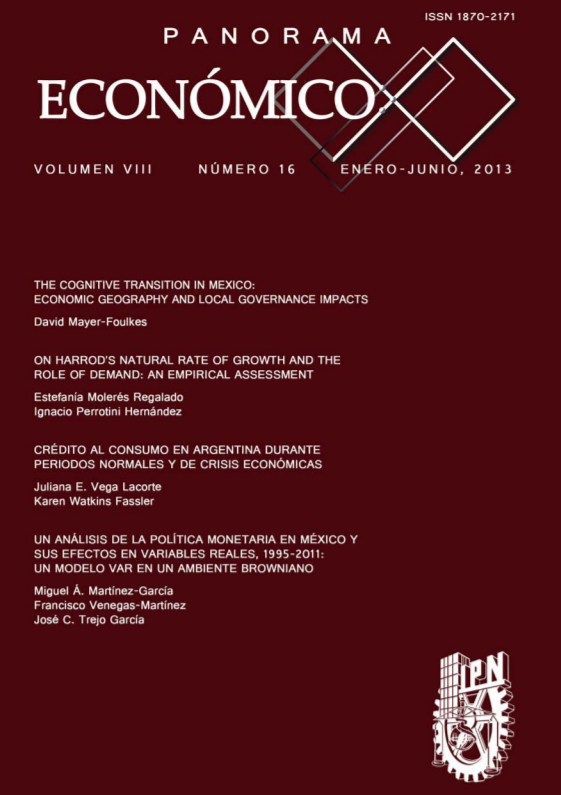Crédito al consumo en Argentina durante periodos normales y de crisis económicas
Contenido principal del artículo
Esta investigación indaga sobre la relación entre factores macroeconómicos y la decisión de las familias para financiar su consumo con deuda. Particularmente, se estudia la correspondencia entre el ingreso, la tasa de interés, el desempleo y la confianza de los consumidores con el endeudamiento de las familias. Se verifica también si las relaciones entre las variables macroeconómicas (particularmente el ingreso) y la deuda para consumo son coherentes con las teorías que se han escrito sobre el consumo. Como estudio de caso se toma Argentina, pues permite el análisis bajo distintos escenarios normales y de crisis económicas (1994-2011).
Ashley, D. W. (2002), "The Demand for Consumer Credit", Unpublished Master's Thesis, Virginia Polytechnic Institute and State University.
Barnes, S. y G. Young (2003), "The Rise in US Household Debt: Assessing its Causes and Sustainability", Bank of England Working Paper, 206.
Baumohl, B. (2007), The Secrets of Economic Indicators: Hidden Clues to Future Economic Trends and Investment Opportunities, 2a ed., Wharton School Publishing.
Boorstin, D. (2004), "Credit History: The Evolution of Consumer Credit in America", The Ledger: Economic Education Newsletter, 16.
Boot, J. C. G., W. Feibes y J. H. C. Lisman (1967), "Further Methods of Derivation of Quarterly Figures from Annual Data", Journal of the Royal Statistical Society, vol. 16, núm. 1, pp. 65-75.
Calder, L. (2002), "The Evolution of Consumer Credit in the United States", en T. A. Durkin y M. E. Staten (Eds.), The Impact of Public Policy on Consumer Credit (pp. 336). Norwell, Massachusetts: Kluwer Academic Publishers.
Cox, R. (1948), The Economics of Instalment Buying, New York: The Ronald Press Company.
Chen, B. (2007), "An Empirical Comparison of Methods for Temporal Distribution and Interpolation at the National Accounts", BEA Working paper, 2007-03.
Chen Chen, K. y M. Chivakul (2008), "What Drives Household Borrowing and Credit Constraints? Evidence from Bosnia and Herzegovina", IMF Working Paper, 08/202.
Chow, G. C. (1960), "Tests of Equality Between Sets of Coefficients in Two Linear Regressions", Econometrica, vol. 28, núm. 3, pp. 591-603.
Chrystal, K. A. y P. Mizen (2001), "Consumption, Money and Lending: A Joint Model for the UK Household Sector", Bank of England Working Paper, núm. 134.
Dauten, C. A. (1954), "A Fresh Approach to the Place of Consumer Credit in Economic and Financial Thinking", The Journal of Finance, vol. 9, núm. 2, pp. 111-123.
Deaton, A. (2005), "Franco Modigliani and the Life Cycle Theory of Con-sumption", Research Program in Development Studies and Center for Health and Wellbeing, 22.
Del Rio, A. (2002), "El endeudamiento de los hogares españoles: evolución y factores explicativos", Boletín Económico Banco de España, 11(228):47-54.
Desroches, B. y M. A. Gosselin (2002), "The Usefulness of Consumer Confidence Indexes" in the United States, Bank of Canada Working Paper, 02-22. Dion, D. P. (2006), "Does Consumer Confidence Forecast Household Spending?", MPRA Paper, núm. 902, University Library of Munich, Germany.
Duesenberry, J. S. (1949), Income, Saving, and the Theory of Economic Behavior, Harvard University Press.
Durkin, T. A. y M. E. Staten (2002), "Introduction", en T. A. Durkin y M. E. Staten (Eds.), The Impact of Public Policy on Consumer Credit, Kluwer Academic Publishers, pp. 336.
Earl, P. E. y S. Kemp (2002), The Elgar Companion to Consumer Research and Economic Psychology, Edward Elgar Publishing.
Enthoven, A. (1957), "The Growth of Instalment Credit and the Future of Prosperity", American Economic Review, vol. 47, núm. 6, pp. 913-929.
Friedman, M. (1957), A Theory of the Consumption Function, National Bureau of Economic Research.
Gross, D. B. y N. S. Souleles (2001), "Do Liquidity Constraints and Interest Rates Matter for Consumer Behavior? Evidence from Credit Card Data", The Quarterly Journal of Economics, vol. 117, núm. 1, pp. 149-185.
Haberler, G. (1942), Consumer Instalment Credit and Economic Fluctuations, New York: National Bureau of Economic Research.
Jiménez, F. (2001), Macroeconomía: Enfoques y Modelos, Tomo I, Lima: Fondo Ed. PUCP.
Keynes, J. M. (1936), The General Theory of Employment, Interest, and Mone, London, Macmillan (reimpreso en 2007).
Kisselgoff, A. (1952), Factors Affecting the Demand for Consumer Instalment Sales Credit, vol. 1, New York: National Bureau of Economic Research.
Lewis, R. E. (1956), "Some Factors in the Growth of Consumer Credit", The Journal of Finance, vol. 11, núm. 2, pp. 249-256.
Logemann, J. (2008), "Different Paths to Mass Consumption: Consumer Credit in the United States and West Germany during the 1950s and 60s", Journal of Social History, pp. 525-559.
Ludvigson, S. C. (2004), "Consumer Confidence and Consumer Spending" Journal of Economic Perspectives, vol. 18, núm. 2, pp. 29-50.
Magri, S. (2002), "Italian Households' Debt: Determinants of Demand and Supply", Temi di discussione del Servizio Studi no. 454, Banca d'Italia.
Makin, J. H. (1977), Macrocconomía, (V. M. Armer, Trans. 1. ed.), México, D.F., Nueva Editorial Interamericana, S.A. de C.V.
Mason, R. (2000), "The Social Significance of Consumption: James Duesenberry's Contribution to Consumer Theory", Journal of Economic Issues, vol. 34, núm. 3, pp. 553-572.
Morales R., L. y O. A. Yáñez (2006), "Créditos de consumo bancarios: evolución reciente 1997-2005", Serie Técnica de Estudios, núm. 003. Super-intendencia de Bancos e Instituciones Financieras (SBIF)(003).
Neagu, F. y A. Margarit (2007), "Risks to Romanian Financial Stability Stemming from the Household Sector", IFC Bulletin, núm. 26, pp. 75-108.
Palley, T. (2007), "The Relative Income Theory of Consumption: A Synthetic Keynes-Duesenberry-Friedman Model", Working Paper Series, núm. 170, Political Economy Research Institute.
Park, S. (1993), "The Determinants of Consumer Installment Credit", Federal Reserve Bank of St. Louis Review, November/December, pp. 23-38.
Pearce, D. K. (1985), "Rising Household Debt in Perspective", Economic Re-view, Federal Reserve Bank of Kansas City, pp. 3-17.
Shiskin, J. (1974), "The Changing Business Cycle", The New York Times, p. 222.
Soto, C. (2004), "Desempleo y consumo en Chile", Documento de Trabajo, núm. 258, Banco Central de Chile.
Strebkov, D. (2005), "Household Borrowing Behavior in Russia", Problems of Economic Transition, vol. 48, núm. 5, pp. 22-48.
"The Conference Board", <http://www.conference-board.org/>.
Tinbergen, J. (1942), "Does Consumption Lag Behind Incomes?", The Review of Economics and Statistics, vol. 24, núm. 1, pp. 1-8.
Tudela, M. y G. Young (2005), "The Determinants of Household Debt and Balance Sheets in the United Kingdom", Bank of England Working Paper Series, núm. 266.
Weller, C. E. (2007), "Need or Want: What Explains the Run-up in Consumer Debt?, Journal of Economic Issues, vol. 41, núm. 2, pp. 583-591.
Wilcox, J. A. (2007), "Forecasting Components of Consumption with Components of Consumer Sentiment", Working paper, University of California, Berkeley.
Detalles del artículo

Esta obra está bajo una licencia internacional Creative Commons Atribución-NoComercial-SinDerivadas 4.0.







